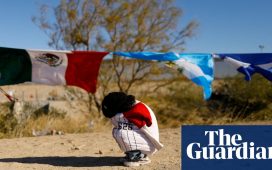A US government smartphone app that tightly limits asylum appointments at the US-Mexico border is stranding vulnerable migrants in Mexico and enriching organised crime groups, according to a new report from Human Rights Watch (HRW).
The report, which draws on interviews with more than 100 migrants, as well as officials and activists, documents how the CBP One app – which is all but mandatory for asylum seekers – offers 1,450 appointments a day, when arrivals at the border averaged 7,240 a day between May 2023 and January 2024.
This “digital metering” means that asylum seekers must either wait for an appointment or resort to paying human trafficking groups to help them cross the border between ports of entry.
“The Biden administration claims that its asylum rule and effectively mandatory use of CBP One will disrupt smuggling networks,” said the report. “Human Rights Watch has observed that, on the contrary, digital metering in Mexico leaves asylum seekers vulnerable to extortion, kidnapping, and violence.
“And, with no other way to access protection, asylum seekers are more likely to engage smugglers, further enriching criminal cartels,” added the report.
The CBP One app became a requirement for asylum seekers in May 2023, as the US prepared to lift Title 42, a pandemic-era restriction on immigration, and anticipated a sharp rise in arrivals at the border.
That uptick in arrivals never materialised – but CBP One was nevertheless maintained.
There are certain exceptions to the requirement of a CBP One appointment, including those who can show “an imminent threat of rape, kidnapping, torture, or murder”, or “a severe form of trafficking in persons”.
However, HRW investigators document instances of asylum seekers being turned away despite describing how they face such threats in Mexico.
Rather than wait for an appointment in Mexico, many try to cross the border between ports of entry. Some drown in the Rio Grande river, while others die of dehydration in the Sonoran desert.
According to CBP data, 895 people died at the border during the 2022 fiscal year, the last year for which data has been released. That marked a 57% increase on 2021. Local organisations say it undercounts the true number.
Those who choose to wait for an appointment may spend months at risk of kidnap from organised crime groups.
“It’s systematic,” said Ari Sawyer, a researcher at HRW. “They kidnap them, put their phones on airplane mode, take photos of them and their documents, then go through their contacts and call US numbers until they find relatives they can extort for dollars.”
One person interviewed by HRW described being kidnapped in the state of Durango and seeing perhaps 150 others in the stash house where he was held. Another, who was kidnapped in Mexicali, said he saw two people shot and killed when they resisted.
Human Rights First, a human rights organisation, documented 13,480 publicly reported cases of kidnapping and other violent attacks on migrants during the Biden administration up to December 2022.
Rather than offering protection, Mexican officials sometimes collude with organised crime.
In one case, the mayor and chief of police in Matehuala, a city in the state of San Luis Potosí, were arrested for their part in a migrant kidnapping ring.
Officials also frequently force people on to buses that take them back south in Mexico – an informal policy that has been expanded during the presidency of Andrés Manuel López Obrador.
“These people have crossed Central America, they’ve gotten through Mexico, they’re waiting for a CBP One appointment – and then Mexican immigration sweeps them up, puts them on a bus, and forcibly transports them to the border with Guatemala,” said Sawyer.
This is part of Mexico’s role as US immigration enforcer, tasked with reducing arrivals at the border.
Last year, the official number of detentions of migrants soared to 800,000. The first three months of 2024 have already seen almost 400,000.
When migrants are detained in Mexico, it is unclear what processes are being followed to determine how long they are held for, where they are released, and whether they are repatriated. But the longer they spend in Mexico, the greater the risks they run.
“An app-based appointment system suggests the illusion of order and impartiality, but in reality CBP One puts people in danger and means more profit and power for criminal cartels,” said Sawyer. “The United States and Mexico can and should do better.”












